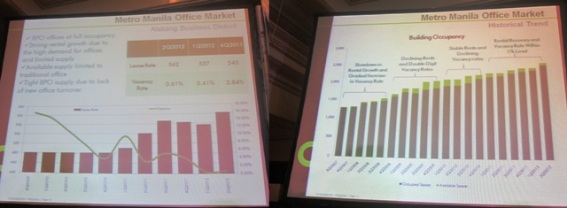Is there a really a real estate bubble developing in the country? Real estate professionals are worried about the bubble, especially now that the country is experiencing real estate boom.
During the “Is a Bubble in the Philippine Real Estate Sector Developing?” seminar last October 23, Mr. David Leechiu and Dr. Winston Padojinog discussed the bubble issue directly.
The data presented by Dr. Padojinog, which included excess liquidity, the presence of price premiums, and excess supply suggests that a bubble is indeed forming in the higher-end residential market segment. Meanwhile Mr. Leechiu’s discussion of the office market appears to support a stable view of that segment.
And while no evidence was presented during the seminar, there was consensus among the speakers that the retail sector was likewise stable, given a preponderance of anecdotal evidence.
The speakers emphasized that their projections are based on what multilateral agencies are expecting, which factors in a weak US recovery, a European fiscal crisis, a volatile Middle East and a China losing steam. Unforeseen events can easily accelerate the local real estate bubble’s expansion and cause it to burst causing debilitating economic damage.
ENJOY GOOD LIFE + INVESTMENT, CLICK HERE
Steps must be taken to mitigate such an event. Dr. Padojinog states that the “key is to release the pressure and deflate the bubble” and that this should involve “diversifying the lending portfolio of banks by improving the investment prospects of other sectors.” He also recommended repositioning residential projects to cater to underserved segments as well as monitor “shadow banking,” which are informal financing activities in the real estate sector.
According to Dr. Padojinog, who already declared many times that there is really a real estate bubble in theupper and middle income housing markets, the four factors to determine the presence of real estate bubbles are highly liquid financial system, loosening of banks’ lending standards, prevailing market value not supportive of fundamental value of asset, and supply exceeds housing demand.

Are the high end projects the source of developing real estate bubble? (Photo source: www.bestblogmanila.com)
This excess liquidity is going to the high end residential projects because most owners of excess liquidity are top income groups. This is not good since buyers are not end users but investor/speculators and too much supply of leasable space will put a downward pressure on lease income and therefore income values (ultimately market value).
Dr. Padojinog discussed the loosening of Banking Standards and supply exceeding market demand.
He doesn’t see any loosening of bank lending standards and on the market demand, there is a 3 million unit housing backlog for low cost, economic and socialized housing while on the middle cost and high end housing market, there is a surplus of 475,000 units.
Because of this, the main danger now for real estate bubble bursting comes from the middle and higher end housing market segments.
Dr. Padojinog advises developers to give priority the underserved markets such as low cost housing.
Unspoken was the issue that lower end housing projects generate lower yields and that developers always believe their higher end projects will be/are different from others’ projects and therefore will not suffer low take-up rates.
At some point the banks must step in and limit lending to higher end real estate projects or at least increase the lending rates for such. The BSP, on the other hand, cannot increase interest rates to discourage real estate investments because other industries will be affected negatively.
Mr. Leechiu of Jones Lang La Salle, on the other hand, discussed the demand for office buildings in the Philippines. According to him, the growth of Business Process Outsourcing industry will continue to grow until 2015.
At present, the country’s local office market is one of the largest in Asia, accounting to a total of 7.9 million square meters of effective demand. But, it is the 2nd or 3rd cheapest with P1,000 per square meter rental.
Assuming 2011 conditions, almost all new demand is generated by BPOs. Based on 2011 data, the demand for office spaces is approximately 360,000 square meters per annum. This is easily met and surpassed by incoming demand, which is expected to exceed the running average until 2015. Pipeline supply can meet this demand.
If the economy takes off due to sound macroeconomic fundamentals, the running average for annual demand will be about 400,000 square meters. This will just about balance pipeline supply and expected demand surpluses.
What drives JLLS confidence is the amount of pre-building commitments that continue to be place by its clients. The BPO sector will definitely continue to grow until 2015.
Growth will be coming from demand for Bonifacio Global City, GBC, office space because more firms are relocating to Bonifacio Global City, GBC, with many of them want new space or upgrade from Makati. What makes GBC superior to Makati CBD because of infrastructure and planning. Currently, GBC capital values are about 30% higher than in Makati. Most JLLS transactions in GBC range from PhP500 million to PhP2 billion while the few in Makati in 2011 fetched less than PhP500 million. JLLS itself transacts an average of PhP1 billion per year in GBC.
Quezon City, the country’s largest city, is the next big thing. It has a lot of space and has easy access to the workforce. The infrastructure is also sufficient and can be easily improved.
The next big market in the medium term is Quezon City, or QC. QC has a lot of space and has easy access to skilled labor.
FTI, in which the Ayala Corporation won the bidding from the government, will also be an attractive proposition because of location.
In the case of a new round of financial crisis triggered by problems in the Eurozone, Middle East, or Asia, there will be a 12-month to 18-month lag in demand deflation in office space. That means that the earliest negative repercussions can be felt in 2014 if a crisis develops right now.
In the case of the economy lifting off due to government fiscal and political reforms, brick and mortar business demand will start picking up in 2013. Many multinational companies are already scouting the Philippines for likely offices and plant locations. Speculative demand will translate to effective demand when reforms continue and no new major external or internal crises develop.
The Philippines has been growing at least by 4% on average despite major internal and external crises for the past three decades. JLLS believes that most political and economic risks have already been factored out by investors.
JLLS expects a credit upgrade soon and this will be accompanied by a surge in traditional brick and mortar business investments by foreigners and locals. The JLLS projection of 400,000 square meters per annum as expected demand might be too conservative in such a case.
Moving forward, labor is a major bottleneck. Scalable skilled labor can only be found in Metro Manila and Cebu. Other Philippine cities will be hard-pressed to grow office space, even Davao and Baguio will be difficult to grow because of the education quotient.
The Cebu market is about 10% of the NCR market. Investors are required a physical (disaster) back-up site where they allocate 10% to 20% of their capacity and they choose Cebu because of the scalable labor pool and infrastructure. To underscore Cebu’s secondary quality, JLLS offers Cebu office space at PhP150 to PhP250 per square meter and as yet there are no takers.
Baguio is no longer an option due to lack of reliable airport facility while Davao has been discounted due to lack of scalable labor.
To summarize, JLLS believes office space demand is stable and there is no threat of it collapsing under a bubble scenario.
With these developments, is there really a real estate bubble developing in the country?
With sources from: MR. ROQUE SORIOSO, JR. & http://cuervopropertyadvisory.wordpress.com/2012/10/31/is-there-really-a-real-estate-bubble/


No comments:
Post a Comment